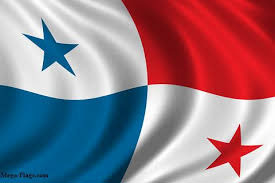PANAMA
Feb. 2014
2014 was not starting out very well at all. My fairly-new truck was hit and badly damaged just a few days after Christmas (it was 3 weeks before it came out of the shop). The winter was harsh and long – snow, extreme cold, dark and bitter. The condo above ours had been foreclosed upon and uninhabited for the past couple of years. We occasionally checked on it, and with the coming of the polar plunge and drastic cold, we made a visit to make sure all was well. It was not.
After more than 2 years, the electricity had apparently been turned off (but not the gas, surprisingly someone was still paying that bill). That meant there was no heat, and that meant frozen pipes. 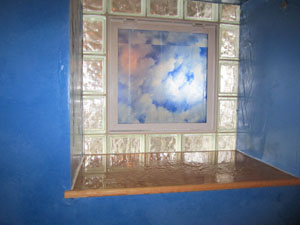 We immediately made arrangements to have the electricity turned back on and Allen stayed home that day – January 8 – to monitor what would happen when the pipes began to thaw. He called me mid-morning to let me know that pipes had burst, that our unit was being flooded, and that there was nothing he could do to staunch the flow. I immediately left work to go home, the 40 minute train ride feeling more like a 4 hour trek. I came home to find water running down the walls, from light fixtures, coming out from the brick wall and running outside, a lot of it already frozen into an ice curtain blocking the view out our window, freezing the kitchen door shut. Shoes were floating the length of the downstairs hallway.
We immediately made arrangements to have the electricity turned back on and Allen stayed home that day – January 8 – to monitor what would happen when the pipes began to thaw. He called me mid-morning to let me know that pipes had burst, that our unit was being flooded, and that there was nothing he could do to staunch the flow. I immediately left work to go home, the 40 minute train ride feeling more like a 4 hour trek. I came home to find water running down the walls, from light fixtures, coming out from the brick wall and running outside, a lot of it already frozen into an ice curtain blocking the view out our window, freezing the kitchen door shut. Shoes were floating the length of the downstairs hallway.
Despair, helplessness, fear, anger, disbelief, sadness – every negative emotion possible were flowing though us both – and we needed to figure out what to do. We had consulted the other residents of the condo as to individual water cut-offs – no one knew of any. No one was sure about any water cut off. I called the city, requesting emergency water cut off and then waited. Waited as we tried to move things out of the way of the water, but helpless to do much about it.
After more than half an hour of waiting, feeling very desperate, I went to the basement area of the building and discovered a 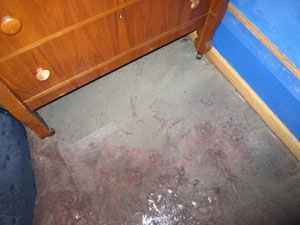 large valve handle. I was not sure it was the water, but decided to close it anyway. The water stopped flowing; the indoor shower came to an end; the water was off – for everyone in the building. There was a moment of relief, but that was soon overshadowed by all the damage the water had done. The dogs were freaked out, we were freaked out, but things had to be done. The water cut off request had to be canceled, we had to find a plumber who could come right away (hard to do – this sort of thing was happening all over the city) insurance companies called, we had to find a restoration service, damages assessed, some order restored. We had to do something.
large valve handle. I was not sure it was the water, but decided to close it anyway. The water stopped flowing; the indoor shower came to an end; the water was off – for everyone in the building. There was a moment of relief, but that was soon overshadowed by all the damage the water had done. The dogs were freaked out, we were freaked out, but things had to be done. The water cut off request had to be canceled, we had to find a plumber who could come right away (hard to do – this sort of thing was happening all over the city) insurance companies called, we had to find a restoration service, damages assessed, some order restored. We had to do something.
The plumbers came and showed me where the individual unit cut off was at in the unit that caused the problem, which allowed me to find our own (just in case). Water was restored to the building after only a couple of hours. After 2 days of cutting into walls and ceilings the plumber would eventually find and replace over 9 burst pipes.
The restoration company came and cut long and wide swathes out of our ceiling, took down kitchen cabinets, removed all the 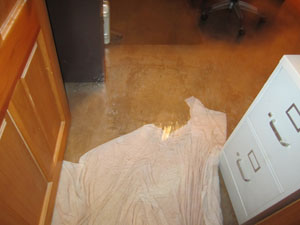 dry wall of one kitchen wall and the lower bedroom wall. There were large holes cut in closets where water had been dripping, the hallway flooring had to be taken up, there was a film of mud from the dust and dirt behind the walls that covered the entire lower floor, the upper wooden floors were warped from the moisture. Furniture that was in the way was moved and put in places that were hard to get around. Plates and glasses, pots and pans, clothing, the entire house was turned upside down. Dust was everywhere, nothing was where it belonged, contents from entire closets were now sitting in the living room or lying on the piano in the guest room.
dry wall of one kitchen wall and the lower bedroom wall. There were large holes cut in closets where water had been dripping, the hallway flooring had to be taken up, there was a film of mud from the dust and dirt behind the walls that covered the entire lower floor, the upper wooden floors were warped from the moisture. Furniture that was in the way was moved and put in places that were hard to get around. Plates and glasses, pots and pans, clothing, the entire house was turned upside down. Dust was everywhere, nothing was where it belonged, contents from entire closets were now sitting in the living room or lying on the piano in the guest room.
In all the running around, I managed to slip and severely pull and bruise my hamstring. It would keep me in pain for the next 6 weeks – but only when I tried to walk, sit, drive or lay down. Amazingly, by the time we got to Panama, it had pretty well healed itself, though I like to credit the warming of the body in the sun as being the real cure.
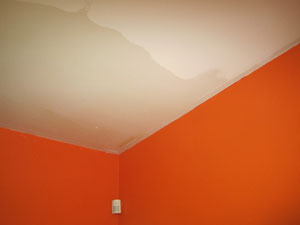 Roaring drying fans were set up for days to dry the moisture and help prevent the growth of mold. Sane people might have moved out and taken shelter elsewhere. But sane people do not have 4 dogs. Sane people might have boarded the dogs, but we make no claim to sanity. The guest/piano room had only minor water damage, but not so much that walls or ceilings had to be removed, so it remained somewhat “usable”, the same could be said for the office. The upstairs, looking like a mini-Katrina had come through, was somewhat usable, if we didn’t mind picking through the “wreckage” wiping things down, and being very cold (we lost all insulation provided by the drywall and we could feel the wind coming through the bare-brick wall).
Roaring drying fans were set up for days to dry the moisture and help prevent the growth of mold. Sane people might have moved out and taken shelter elsewhere. But sane people do not have 4 dogs. Sane people might have boarded the dogs, but we make no claim to sanity. The guest/piano room had only minor water damage, but not so much that walls or ceilings had to be removed, so it remained somewhat “usable”, the same could be said for the office. The upstairs, looking like a mini-Katrina had come through, was somewhat usable, if we didn’t mind picking through the “wreckage” wiping things down, and being very cold (we lost all insulation provided by the drywall and we could feel the wind coming through the bare-brick wall).
It has now been over 2 months since the disaster. We are still sleeping on the futon in the guest room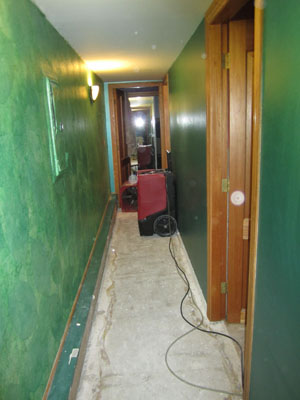 , which is still crowded with clothing, and items that belong in other rooms. We dress out of boxes; we hunt through storage tubs for shoes and sweaters. The contractors are almost done with their work, but not quite. We still live with more dust than we like, but all the walls are up, the floor has been sanded and is once again smooth, most walls are painted, new flooring runs the length of the hall way. The master bedroom is going to take a while longer. There is still a kitchen back-splash to be put in; wallpaper is on order. The work, like the winter, is long and wearing on so many levels.
, which is still crowded with clothing, and items that belong in other rooms. We dress out of boxes; we hunt through storage tubs for shoes and sweaters. The contractors are almost done with their work, but not quite. We still live with more dust than we like, but all the walls are up, the floor has been sanded and is once again smooth, most walls are painted, new flooring runs the length of the hall way. The master bedroom is going to take a while longer. There is still a kitchen back-splash to be put in; wallpaper is on order. The work, like the winter, is long and wearing on so many levels.
But this is supposed to be a trip-log. This is supposed to be about warm and sunny Panama. A trip inspired by my having read David McCullough’s wonderful book The Path Between the Seas about the building of the Panama Canal. Secondary inspiration coming from pictures posted on Facebook by a friend of mine who had spent his own vacation there. A trip financed by the fees I charge for doing weddings. This is supposed to be about escaping, relaxing, enjoyment. And it is. I just thought it needed a little context. It made the holiday all the more needed and special. We had been planning the trip since October, knowing it would be a pleasant withdrawal from the normally long and cold Chicago winter, but never anticipating it would come at such a needed time, in the midst of such a mess. Arrangements had already been made to board the dogs and the contractor agreed that it would be the ideal week to sand and smooth out the wooden floors (a process which would require we desert the house for at least 5 days) – so there was another benefit in leaving when we did.
MORE FLOOD PHOTOS HERE
This was a trip unlike others I had taken outside of a large group tours. After spending all our time in Puerto Rico at a single site, I was not going to let that happen this year – I was intent on more variety, more experiences, seeing more of the country than a single city. Therefore, I made arrangements for several excursions during our vacation. My preference is always to get to a place and then discover the various things to do, walk a lot, see the streets and move in a rather unplanned and spontaneous way. Traveling with a spouse who likes a bit more planning and less serendipity made me go the more pre-planned route. And it worked. We got to see Panama City, the rainforest and the coast.
The evening before our departure, the dogs were dropped off at the boarding kennel. We have used the same boarding company for years and the dogs really like it. Once we arrived, Dale was immediately trying to force his way into the back area where the dogs were actually kept. They never looked back as they were led away to their home for the next 9 days. So much for missing their humans (he wrote with scarred ego).
Tues., Feb. 11, we were up at 4 on the morning of our departure and on the road by 5:15. It was an amazing time to be on the road in Chicago – one of those very rare times when you can travel the expressways at a speed more than 30 mph. I missed the exit for our parking lot and so ended up in another, bit more expensive lot, but also closer to the airport tram that would take us to O’Hare. It was cold – maybe 6° and a -4° wind chill.
We were flying Copa Airlines. I had never heard of it before, but it offered a non-stop flight to and from Panama. As it turned out, it was a very pleasant airline to deal with. Without baggage to check-in, security and boarding went pretty easily and we departed right on time. Fortunately, it was not a full flight and we had plenty of room in the plane and were able to spread out and make ourselves as comfortable as possible for our 51/2-hour flight. This was a special godsend in that I was in a middle seat and the passenger in the window seat must have bathed in his cheap cologne – I was literally choking.
Arriving about 2 in the afternoon, it was immediately apparent that we were out of the snow belt. It was about 90 degrees and the long pants and jackets that we were wearing seemed now twice as heavy as they did in Chicago. There was the smell of the sea and the tropics in the air. Already the vacation was a success. I was literally grinning ear-to-ear with the sheer pleasure of being warm.
We were picked up by a driver from the tour company who gave us a running description of what we were seeing - identifying the taller and more interesting buildings along the skyline of the fully modern, and so homogenized, Panama City as well as the ruins of the ancient settlements. He asked us about our itinerary and when we told him where we were going to be at during the beach leg of our journey, he said he knew the resort and that a lot of older people go there. Allen and I looked at each other – humor and resignation crossing both our faces – we are now part of the older crowd. Oh well… Allen was sure to ask all our guides and drivers if this were so whenever we met them.
Our hotel was set along the water at the entrance to the canal, very near the Bridge of the Americas which straddles either 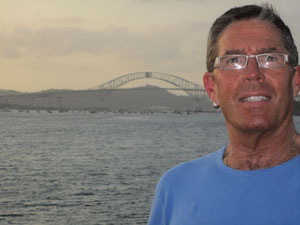 side of the canal and at the mainland end of the Amador Causeway. The causeway was built from rock that was extracted during the making of the canal and links three small islands to the mainland. It also acts as a breakwater for the entrance to the canal. There were plenty of ships and boats waiting their turn through the canal. Our driver informed us that the causeway and the shops, nightclubs and restaurants found on the 4 islands were very popular with the locals and less a tourist area.
side of the canal and at the mainland end of the Amador Causeway. The causeway was built from rock that was extracted during the making of the canal and links three small islands to the mainland. It also acts as a breakwater for the entrance to the canal. There were plenty of ships and boats waiting their turn through the canal. Our driver informed us that the causeway and the shops, nightclubs and restaurants found on the 4 islands were very popular with the locals and less a tourist area.
After taking our room and getting into more tropical attire, we headed down that causeway to find something to eat. It was great to be outside, in shorts, blue sky above, the sea on either side of us… and it was warm!
We grabbed a sandwich and local beer, and continued our walk for another hour or so to the first island and shopping area. With a great view of the city sky-line on one side and the canal on the other, the walk was both pleasant and beautiful. The causeway is a two lane road and a well maintained bike path running along the canal-side water’s edge. Dotted along the way were bicycle rental shops where you could rent a cycle with 1-2-4 and even 6 seats. There were a number of joggers as well, and signs all along the way advertising the Panama Iron Man competition which would be taking place that weekend. The first few miles of the causeway from our hotel is not heavily developed, there were long stretches without buildings or construction. We did pass a complex of buildings that seem to be an entertainment center of sorts – a collection of bars and restaurants – but we were way too early for any of them to be open. We also passed what looked like a hotel complex that failed before it was fully completed. In what would have been the in-door parking lot was housed an indigenous arts sort of mall. A number of booths had been constructed and people were hawking everything from the most beautiful hand-made masks and fabrics to cheesy, touristy bottle openers and magnets (surely made in China). Closer to the island, we passed the Smithsonian Tropical Research Institute where we were able to see a number of what looked like fish hatcheries.
We didn’t see a lot of wildlife on this walk – but we did see and hear lots of cabs. Throughout our walk cabs would honk, slow down and pull over – we literally had to wave them on. It was as if they could not believe that two, apparent tourists, would really prefer walking in the sunshine rather than sitting in their air-conditioned vehicles. It really was about the journey more than the destination. And, after having learned his lesson in Puerto Rico the year before, Allen wore shoes that did not cripple him, thus allowing us both to enjoy our little hike.
Arriving at the first island, we began our search for wine, bourbon or the ingredients for a margarita. Allen was rather disbelieving that we could be in a Latin country and that the liquor store would not have margarita mix. We scoured the shelves of every potential store, but none could be found so we decided to settle for whatever the hotel bar might offer. The part of the island directly off the causeway is filled with restaurants, bars and other entertainments and the local marina and bar seemed especially busy.
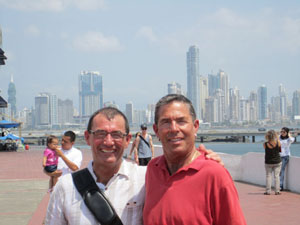 The return was going to be a long walk after a long day, so we decided to try taking a bus. We had seen buses up and down the road, but there were no clearly marked bus stops that we could find. As we walked along looking, we ran into a Canadian couple, standing on the side of the road, also looking for a bus. She informed us that if we did not have a bus pass, we would not be able to ride, but that she thought she had plenty of rides on her pass, so we were welcome to use them. We stood and waited, talking about their vacation and hotel. They were an absolutely charming couple, laughing and joking, telling us what they had learned of the city after being there a week (they had two more to go) and how grateful they were to be out of Alberta. After quite a wait and still no bus, we all decided to try a cab instead - the woman explaining just how inexpensive cabs were.
The return was going to be a long walk after a long day, so we decided to try taking a bus. We had seen buses up and down the road, but there were no clearly marked bus stops that we could find. As we walked along looking, we ran into a Canadian couple, standing on the side of the road, also looking for a bus. She informed us that if we did not have a bus pass, we would not be able to ride, but that she thought she had plenty of rides on her pass, so we were welcome to use them. We stood and waited, talking about their vacation and hotel. They were an absolutely charming couple, laughing and joking, telling us what they had learned of the city after being there a week (they had two more to go) and how grateful they were to be out of Alberta. After quite a wait and still no bus, we all decided to try a cab instead - the woman explaining just how inexpensive cabs were.
We got a cab within minutes, and the driver agreed to drop us off at our hotel and then take the Canadians to theirs deeper in the city. The whole ride was going to cost a total of 8.00. We couldn’t believe it – and our part of the journey was only going to cost 2.00 – we felt generous, paid 4 and bid our Canadian couple goodbye.
The swimming pool was refreshing and we could watch ships going to and from the canal, as well as the many cars going from East to West Panama (and vice versa ) over the Bridge of the Americas (which is also basically, a trip from Central to South America). We ended up taking our night-cap at the TGIFridays attached to the hotel (not the most authentic of Panamanian experiences) and called it a night. The background whirring of the air conditioner a comforting reminder that we were in for a week of needing such an amenity – huzzah!
We were up bright and early the next morning having had a great nights’ sleep. We cleaned up and made our way to the breakfast buffet. There we found ourselves among a real mixture of younger athletes and spry (and not so spry) oldsters. The hotel was filled with people who were there for the upcoming Iron Man competition as well as a large contingent of “Road Scholars” – a program for people interested in life-long learning, new experiences and travel (“interesting trips for old people” as one of the participants referred to it when I asked). The Iron Man participants might have been athletes, but these elders could certainly elbow their way through a breakfast buffet – it wasn’t even a competition.
Our tour-guide for the morning met us in the hotel lobby. His name was Ivan and he would be showing us the city as well as the Miraflores Locks. Ivan was a very pleasant and enthusiastic guide who seemed to really enjoy his work. He dropped us off at the front doors of the canal visitor center and told us to head directly to the 3rd floor observation deck, claim a space and not to give an inch to anyone who might want to get around or in front of us. Ivan was going to park his and then join us. Getting to the center just as it opened and not taking any time to view the exhibits put us first on the outdoor observation deck of the locks. We were able to claim our space at the front railing just as a huge cruise ship (and a cargo ship in the adjoining lock) approached to go through the 2-stage process of being lifted about 54 feet into the lake that allows them to travel to the next set of locks and eventually to the Pacific Ocean.
It seemed all the passengers and much of the crew were out on the decks watching the process and waving at any who would wave back. It is not a speedy process, but when you consider what is being lifted and moved, the 30 minutes or so that it takes to go from ocean to lake is pretty incredible. The fact that there was only about 18 inches clearance on either side of the ship is also mind-blowing. It is also the reason that they are currently busy adding more and much larger locks – the Panama Canal is simply too small for many of the super ships being used these days. Plans are also in the works for a third set of locks as well for even bigger ships. It is an amazing thing to see and ponder.
Looking out over the lake, there are a number of what seem to be islands, but in reality are the tops of the hills and mountains flooded in building the canal. The water isn’t pretty, but as our guide pointed out – the canal is about shipping and some fishing – it is not about swimming or recreation. Ivan explained the entire procedure to us as it was happening, letting us know where the water was coming from, how the gates worked and what the various concerns were in each step of the process. Fascinating and unreal in so many ways, and that it is all man-made is an incredible fact, difficult to wrap your brains around, especially when you think that this all happened in the first 14 years of the 20th century. 2014 marks 100 years since the official completion and opening of the canal.
The visitor center was worth the seeing as well. Through photos, drawings, maps, small models and relics from its history, the 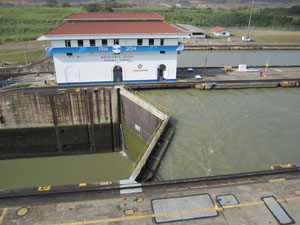 building of the canal was explained and we were given a clear picture of what was happening behind the scenes, what it took to do what we had just seen done in the locks. There were also some really fun and interesting wall art that, when a flash picture is taken, it has a 3-D effect that makes it look as though you are actually part of the portrayed scene. Very clever. One such display, a sample of the water pipes that the water flows through, used some sort of lighting that made it seem as though you were walking in water, ripples appearing with every step (flashbacks of our condo flood).
building of the canal was explained and we were given a clear picture of what was happening behind the scenes, what it took to do what we had just seen done in the locks. There were also some really fun and interesting wall art that, when a flash picture is taken, it has a 3-D effect that makes it look as though you are actually part of the portrayed scene. Very clever. One such display, a sample of the water pipes that the water flows through, used some sort of lighting that made it seem as though you were walking in water, ripples appearing with every step (flashbacks of our condo flood).
From the canal, we were taken to what our guide proclaimed was Panama Antigua (which he wanted to distinguish from Panama Viejo – though most of the guide books don’t make that distinction). On our drive from the airport the day before, the driver had pointed out a number of very old ruins. Telling us that this was the site of the original Panama settlement, much of which was carried and relocated brick by brick when the city was moved to its current site in the 1670’s (it seems that pirates attacked and destroyed the original settlement, causing the move). What Ivan was showing us was the area of that re-settlement. It is now, much like Old San Juan or the French Quarters, a bit of history surrounded by the glass and steel of modernity. There is a marked effort of keeping the feel and look of this area true to its origin. The area is a UNESCO World Heritage site. It is an area of colonial houses, narrow roads and remarkable churches (as well as ruins of churches which are no more- but plans are to rebuild them). From the town square, one is surrounded by a number of different architectural styles – all of them beautifully kept and reflecting the different periods of colonization, control and influence.
Apparently there is a gentrifying movement going on, with buildings being bought up and restored (within strict guidelines to maintain their historical integrity) but there are also a number of families who refuse to sell out or move. They tend to be poorer, and it is reflected in the lack of up-keep of their homes. As individual units do sell, they are immediately boarded up by new owners to prevent others from (illegally) moving in and squatting. It seems they wait out the holders-on until an entire building or block is bought before restorations are begun.
The area is home to a number of restaurants and shops, night clubs and homes. The narrow streets, the hills, the view of the bay – all of it really transports a person back to the 16 & 17th centuries and you could forget you were in a very large, modern city. Ivan was a good guide and his English was very understandable. Allen tried to press him on how the Panamanians think about Americans and Noriega. Ivan stayed very diplomatic with his answers. The Americans, now that they no longer control the canal, are quite loved. Noriega was not perceived as especially bad until the U.S. decided he was bad and attacked the country.
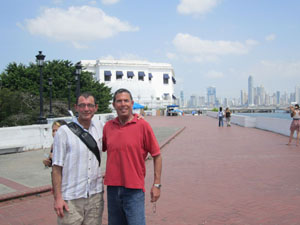 At the highest portion of the wall that once surrounded the city we were treated to a great view of the city skyline and the contrast between the old and the new was profound. I had no idea that Panama was at one time celebrated for its pearls. Its most famous pearl is 31-carats, over 400 years old and was once owned by the Queen of Spain, a French emperor, an English queen and Elizabeth Taylor. Ivan told us that though it is not what it once was; the pearl industry is still alive.
At the highest portion of the wall that once surrounded the city we were treated to a great view of the city skyline and the contrast between the old and the new was profound. I had no idea that Panama was at one time celebrated for its pearls. Its most famous pearl is 31-carats, over 400 years old and was once owned by the Queen of Spain, a French emperor, an English queen and Elizabeth Taylor. Ivan told us that though it is not what it once was; the pearl industry is still alive.
Ivan led us to the governmental buildings outside the old city and, after showing our identity cards to the heavily armed guards, we were allowed to walk in a gated area that enclosed the government buildings and the offices of the president. It seems they keep some live swans in the courtyard of one of the buildings and they will at times attack people. As we walked and looked out onto the water, Ivan pointed to two men who were standing and seemed to be waiting for a car – it was the vice president of the country. Ivan was very excited that we got to see him.
As part of our journey back to the hotel, Ivan drove us down the Causeway, and to the 2 islands that we did not walk to the day before. We also stopped at another liquor store to once again look for margarita makings but settled for a bottle of tequila, some sort mixed fruit punch, and as recommended by Ivan, a bottle of Fresca soda. With tequila, most anything can be made palatable.
After Ivan dropped us at the hotel, we walked back up the causeway to the handicrafts market that we had only briefly looked at the day before. Our living room walls are decorated with masks from various countries. Last year, in Puerto Rico, we failed to bring home a mask, because we were sure there would be a better one at the next store – but the next store never came. I was not going to let that happen on this trip.
Like most Mercado’s that I have visited, the minute the two of us walked in the booth owners began encouraging and even demanding that we walk through their booth, look over their wares, buy something from them. As I said earlier, any number of things could be bought – from the cheesy and foreign-made to the locally produced and beautiful. I wanted a mask. I was a bit put off though at the first ones I looked at. It looked as though they were made from woven strips of plastic. It was not until I asked, and was shown and then could see it for myself, that what I thought was plastic was actually brightly dyed palm fibers. Most of the masks were of the brightly colored birds or darker colored indigenous apes. I really liked a jaguar mask; Allen favored a monkey (my man and his monkeys!), so we settled on a parrot mask that would complement the color scheme of the room. We also got a magnet for the fridge.
By the time we got back to the hotel, we were definitely ready for the pool where we read, swam, looked at the guys arriving for the Iron Man competition and simply basked in the beauty and warmth of what was all around us.
That evening we took our meal at the Yacht Club across the way from our hotel. The first thing we did was order a 32 oz margarita – each. The bartender seemed a bit reluctant to serve them to us, but he did eventually bring us each a huge over-sized margarita glass filled with what turned out to be rather weak but tasty margaritas. Allen’s father has a habit of taking the small shampoos and creams from the hotels he stays at and bringing them home. Allen has taken after his father and gone one better; he seeks out the supply closets and maid carts and supplies himself. As we waited for our dinner and drank from our troughs, Allen decided he would put some cream on my legs. Pulling out one of the small bottles he had brought from the hotel, my leg laying on his lap, he began rubbing it in. But rather than soothing my lightly burned legs, he was simply conditioning my leg hair – it turned out he had brought a bottle of hair conditioner rather than body cream. I’ll bet I had the silkiest leg hair in the city that night.
We were up at 7 the next morning and already it was hot and somewhat humid, but that was not a problem. After a hearty breakfast shared with the Road Scholars and athletes (even more had arrived since the previous morning) we decided to take a walk toward the city. After half an hour of walking through what looked like middle class neighborhoods, Allen turned around and headed back to the hotel, I continued. I walked to the foot of the mountain that looks over the city and canal and is topped off by a huge Panamanian flag – so big it can be clearly seen from miles and miles away. It seemed the tallest point in the city and we had driven by it each time we were taken some place.
This whole neighborhood dated back to the American period. It seems we had declared the 5 miles on either side of the canal to be the militarized Canal Zone. Panamanians were not allowed to shop in the area, though they could pass through relatively un-hampered. The zone became a bone of contention with the locals because it effectively cut the country in two, with an American strip running through the middle. Panamanians could not fly their flag alongside the American flag in the zone, and this caused several flag riots that led to some deaths. The zone had its own police, courts and civic government. There were a number of riots in the 60’s and finally, in 1979, the zone ceased to exist as the slow transfer to the Panamanians began. Much of the housing and other buildings that exist along the canal date from this time of American control.
MORE PANAMA CITY PHOTOS HERE
We were to be picked up at the hotel at noon for our transfer to the rain forest and so I headed back to the hotel to wash off the sweat and dress. On my return, I stopped in a small bodega along the route, for a diet coke. The place ended up also being a small liquor store, and there I found a bottle of Margarita mix – I bought 2. Allen was delighted.
Our route to the rainforest basically followed the canal, taking us by the 2nd lock (no fancy tourist building there), and is quite a pleasant and scenic ride. Our driver did not seem as bi-lingual as the others had been, but he tried his best to explain what we were seeing. We were heading to the Gamboa Rain Forest Resort.
The town of Gamboa was built as a Canal Zone township for laborers and workers. It is located on a sharp bend of the Chagres River at the point where it feeds into Lake Gatun. After crossing through the second lock, ships navigate through this man-made lake and make their way to the third and final lock and then into the Pacific. A single lane iron and wood bridge crosses the very wide Chagres River and is the only road access to Gamboa. There is only room for one lane of traffic and so stop lights allow vehicles to take turns – some coming from and others going to Gamboa. Railroad tracks take up what would have been a second lane. The bridge does not look like it is up-to-date in repair work as there were several pot holes along the way. But, we made it across.
Lying at “the end of the road”, accessible only over that very narrow bridge the town has become but a shadow of its former glory. This has helped to keep the rainforest that lies adjacent to Gamboa relatively undisturbed. Gamboa is about the half-way point between the two oceans and is home to one of the best birding hikes in Panama as well as caymans, crocodiles, iguanas, jaguarundis, opossums and monkeys.
The hotel is now the town’s main attraction, bringing in tourists from all over the world. There is even a special tour package 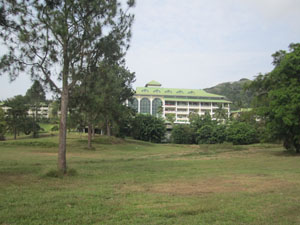 offered by a company and only available to Canadians. The resort is huge, lying on the shore of the lake. It incorporates the former 9-hole golf course (no longer in use), the town’s Clubhouse and a row of typical Canal Zone wooden quarters now rented to tourists. There is also a very large, winding pool with several levels and plenty of area to lie in the sun.
offered by a company and only available to Canadians. The resort is huge, lying on the shore of the lake. It incorporates the former 9-hole golf course (no longer in use), the town’s Clubhouse and a row of typical Canal Zone wooden quarters now rented to tourists. There is also a very large, winding pool with several levels and plenty of area to lie in the sun.
It was only a 45 minute drive from the city and so we were there 2 hours before we could actually get into our room. We left our bags at the front desk and did a walk-about of the resort, walking out to the dock, hoping to see some wildlife (we did see a turtle). All the rooms at the resort have a balcony facing the water and a hammock. After his experience with the hammock, Allen has decided we need to have one for our (very small) porch back home. Luckily, he put off the purchase of said hammock until we get back to Chicago (so maybe the purchase can be put off – forever). Their pool was heavenly.
The lodge has three restaurants (one located at the resort marina), a bar and a disco. Two of the restaurants required reservations the third offered both buffet and ala-carte dining. We began the evening on our balcony with margaritas, trying out the hammock, watching the sunset reflecting off the lake waters. At the restaurant we elected to eat outside on the terrace. That lasted almost 15 minutes before Allen got attacked by mosquitoes and so we relocated inside. Allen does not get along well with mosquitoes and tends to react with big, itchy welts.
We got a lot of attention from the English speaking “ambassador” for the lodge. He is originally from the Carolinas, married a Panamanian and they have been living in Panama for the last year or so. Both Allen and he were shocked to discover that they both had very similar rings, with similar stones in them. It is especially surprising because Allen’s designed his himself. They were not exact duplicates, but very close. Our waitress was not the best, and seemed to be making her own decisions about what we ordered, luckily our Carolinian verified our order before sending it to the kitchen, otherwise we would have both ended up with club sandwiches – which neither of us ordered. The meal was not the best, their margaritas were not as flavorful as our own, and the wine was just O.K. Disappointing. After dinner, we finished our wine, spoke a bit more with the ambassador and headed to bed.
Valentine’s Day started at the breakfast buffet (much better than the ala carte dinner of the night before – with some incredible hot sauce) and then, along with about 4 other couples, headed out for a boat tour of Gatun Lake. At the time of its creation (1913) it was the largest man-made lake in the world, and the dam the largest on earth. It forms a major part of the canal; ships travel some 21 miles across the lake to the locks that allow them to pass into the Caribbean Sea.
After loading us into the canopied flat boat, we traveled up the river to the lake and were thus officially travelling in the Panama Canal. It was amazing to think about – being in a rain forest, on a huge artificial lake, heading towards islands which are actually mountain tops. Even with all the greenery, the wildlife, and the waters – it was a very unnatural natural setting. Perhaps the impression was caused by the amount of construction, dredging and building going on in order to expand the canal. Huge cuts in the banks were visible, dredging boats were busy, power lines were visible along the lake shores, big ships and lots of heavy machinery – but then you glimpse an alligator, a bright multi-colored bird flies overhead – the contrasts and cognitive dissonance make it all very foreign and a feel of “neither fish nor fowl”.
The boat took us to some island areas. We saw an alligator dive as our boat got too close. Got very close to another island 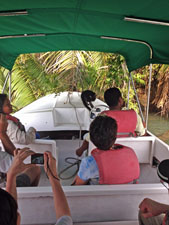 and watched a group of howler monkeys, including some very young babies, all hanging around in the vines and trees and seemingly posing for us. Under the vines, just barely hidden by the shore and water, alligators waited, hoping a monkey would fall – none did – that day. At another island cove, one of our guides grabbed some overhanging vines and began making grunting noises. Suddenly, 2 Capuchin monkeys came swinging out of the trees, and onto our boats. The guide who called them offered them some fruit and they seemed very comfortable on the boat, walking along the edge of it, starting to make their way to where we passengers were sitting. After enough time to get photos and before the monkeys could reach us, the driver backed the boat up a bit, enough to alert the monkeys that it was their time to leave. They must go through this on a daily basis, it all worked too smoothly. Of course, unless they would plop down in his lap or climb onto his back, the monkeys were never close enough for Allen. From what I later read, this enticing of the monkeys is highly illegal (no feeding, getting too close, or allowing monkeys on boats). At yet another island cove, the guide tried to call some other monkeys but they never showed up.
and watched a group of howler monkeys, including some very young babies, all hanging around in the vines and trees and seemingly posing for us. Under the vines, just barely hidden by the shore and water, alligators waited, hoping a monkey would fall – none did – that day. At another island cove, one of our guides grabbed some overhanging vines and began making grunting noises. Suddenly, 2 Capuchin monkeys came swinging out of the trees, and onto our boats. The guide who called them offered them some fruit and they seemed very comfortable on the boat, walking along the edge of it, starting to make their way to where we passengers were sitting. After enough time to get photos and before the monkeys could reach us, the driver backed the boat up a bit, enough to alert the monkeys that it was their time to leave. They must go through this on a daily basis, it all worked too smoothly. Of course, unless they would plop down in his lap or climb onto his back, the monkeys were never close enough for Allen. From what I later read, this enticing of the monkeys is highly illegal (no feeding, getting too close, or allowing monkeys on boats). At yet another island cove, the guide tried to call some other monkeys but they never showed up.
After trolling around yet more islands, seeing the turtles, the birds and other wild life, we returned to the docks and hotel. Allen went to take a siesta and I asked one of the hotel workers where I might buy a bottle of tequila. He gave me directions to the town of Gamboa and tried to tell me where the small store was. It was very hot, but I was up for the walk. I headed down the main road and then to a side road that took me to the far end of the resort and then into the town. Along the way I noted a number of small, dead snakes on the road but never saw a larger or living one, and the large rodents called agouti that seem to be very common.
I was soaked with sweat by the time I got to the town, and it was really a run-down affair. The road had taken me to what once might have been a nice park area, with an abandoned and crumbling church on the edge of the park. There were neighborhood streets; some very run down, others very well kept and nice looking. A small, leaning shed of some sort, sitting in the midst of several picnic tables was selling some sort of fast food and there was a closed hardware store, but no matter where I walked, I could find no store. I wandered around as much as I could before I had to turn around and get back to the hotel for our afternoon tour. My mission had been a failure, but I did get so see more of the area and the peoples who live there – and that is always interesting and enjoyable.
We were taking the aerial tram tour through the forest canopy with a number of other lodge customers. This part of the rainforest is within the boundaries of the resort and some years prior they built the tram over the mile long tract of “their” forest. Much like a ski-lift or carnival ride, we were broken up into groups of 6 or 8- each group having its own guide - and waited for one of the canopied cars to make its way down, where it was stopped, boarded, and then continued along its track. Our guide was very informative about the plant and animal life we were seeing. The tram ride is half a mile long and ascends 280 feet up, the gondolas, at times, brushing the tree tops, eventually depositing us on a hill top. Then it was a 2 minute walk uphill to an observation tower which is ascended by walking up a spiraling ramp taking us to the top of the 100 foot tower. Along the way, our guide pointed out what he called monkey ear plants, kissing-lip flowers, ant mounds created in the trees, and other oddities. At the top of the observation tower we were 500 feet above sea level with great views of the canal, the Chagres River, the surrounding forests and mountains as well as the town of Gamboa. We were also able to see the site of an indigenous village built on islands in the river. The government has allowed the Indians to return to this part of their ancient lands, but they are not allowed to hunt or farm. All wildlife in Panama is protected. So, they are not allowed to fully live their ancient ways, but they can have some sort of village life (and it is also a tourist draw I found out later – we missed that tour). The guide seemed to enjoy telling our car that each day someone dressed in boots and protective gear, bearing a machete, walks the entire route of the tram, cutting back growth and getting rid of the snakes that sometimes find the tram-cars a nice place to sleep. The ladies sharing our car immediately pulled their arms off the sides of the car.
On the way back to the lodge, the bus stopped at another lodge-built attraction. It is a small area where they have their own 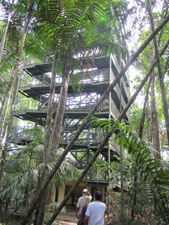 aquarium, serpentarium, small arboretum and butterfly farm. A number of the guests elected not to stop, they were not interested in the snakes. It was a very sad little exhibit. Maybe a dozen snakes in their terrariums, sitting in niches of a faux-cave, many of the terrariums were empty. The butterfly farm was pretty cool, butterflies of varied colors and types flew all about us, lighting on us at times. We were in a fairy-forest of vivid colors, some of them metallic, almost floating all about us. Teasing us as they landed and then pulling away just as we tried to snap their picture. The rest of the day was spent pool-side.
aquarium, serpentarium, small arboretum and butterfly farm. A number of the guests elected not to stop, they were not interested in the snakes. It was a very sad little exhibit. Maybe a dozen snakes in their terrariums, sitting in niches of a faux-cave, many of the terrariums were empty. The butterfly farm was pretty cool, butterflies of varied colors and types flew all about us, lighting on us at times. We were in a fairy-forest of vivid colors, some of them metallic, almost floating all about us. Teasing us as they landed and then pulling away just as we tried to snap their picture. The rest of the day was spent pool-side.
That night we chose to eat from the buffet. It was good. There was too much of it. I pigged out. It made for a restless, sleepless night. After dinner we sat on the patio and finished off our tequila and juices, watched the sun set in a glorious ball of orange that slowly slipped below the horizon and the bright, full moon disappearing and reappearing behind the clouds. It was a truly remarkable night. It is easy to forget how many stars you don’t see when living in the city.
We were both pleased and surprised to find that our driver to the coast was Ivan. He was taking us to the Sheraton Bijao Beach Resort on the Pacific coast. It was about a 90-minute drive that necessitated crossing from East Panama to West Panama over the newer Centennial Bridge (opened in 2004, marking the 100th anniversary of the beginning of the Americans’ constructing of the canal).
MORE PHOTOS FROM THE RAINFOREST
We passed through a number of colorful cities and towns, including the cheese capital of Panama. The road wound its way up and down and around hills until it began to flatten out as we got closer and closer to the coast. We did pass a terrible car wreck and glimpsed those on site trying to pry someone out of the demolished vehicle. Ivan tried to be engaging and informative as we traveled along, but it was apparent that he was feeling a bit worn down and ill. He recalled our hunt for tequila back in Panama, so he stopped at a large grocery store (more like one of our Wal-Mart superstores – they had everything) where we found both tequila and margarita mix. He was really trying to take care of us. We stocked up, failing to recall that “all-inclusive” included drinks.
We got to the resort about 1:30 and had to wait until 3 before we could check in. We walked the grounds, investigated the amenities, and then settled down to wait. I checked with the desk about 2:45 and was told that the wait would be a bit longer – maybe until 3:30. That wasn’t good news, and I went to both Facebook and a travel site to complain. I found out later that Sheraton is good about monitoring social media.
After finally getting into our room, the first thing to be done was hit the pool. It was refreshing and cooling, the perfect counterpoint to the heat of the day. The signs informing us that the pools closed at 7 were rather befuddling. The pool at the rainforest lodge closed at 6, but if you signed a waiver they didn’t care if you stayed longer. There seemed to be no waiver exceptions here. Why the early closures remain a mystery. We were also delighted to find that in spite of our first driver’s remarks – this was not a resort filled with only older folks. There were plenty of younger bodies to look at as well… some as hot as the temperature.
Before going to supper, we wanted to have a drink. We had the supplies, all except the ice. There were no ice buckets, there were no ice machines – we called room service. After 3 more calls and over an hour of waiting, we finally had ice. It was brought to us in a champagne bucket with a dinner plate on top and a number of apologies from the person who brought it. We kept the bucket for the rest of our stay and the social media sites were informed.
Our “balcony” was nothing more than a ledge with railing outside the sliding glass door. However we had a magnificent view 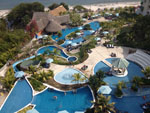 of the pool and ocean. We talked about making reservations in one of the several restaurants that were part of the resort, but we never ate anywhere else other than the buffet. It was always pretty good food, great variety and a nice sampling of native dishes – not to mention some of the very best chorizo I have ever had.
of the pool and ocean. We talked about making reservations in one of the several restaurants that were part of the resort, but we never ate anywhere else other than the buffet. It was always pretty good food, great variety and a nice sampling of native dishes – not to mention some of the very best chorizo I have ever had.
Back at the rainforest lodge, we had engaged a Canadian couple in conversation a couple of times, and we were pleased to find that they too had come to spend some time at this resort. We made a point to get together each evening for supper or after-supper drinks. We would spend time drinking wine, talking about Canada, Chicago, the cold, the canal, health care in the two countries and what we had done or seen each day. It was always congenial and filled with laughter.
On our trip to the resort, Ivan had recommended one of the trips offered by the resort – a visit to El Valle de Anton. After breakfast, we reserved a spot on that day’s trip and boarded the bus with the other tourists (gag – we have become old men). The 45 minute bus ride took us up into the mountains. The town is located in the wide and flat bowl of an inactive volcano some 2000 feet up, meaning it is considerably cooler than the lowlands. Many of the well-off of Panama City have weekend homes here and there are a large number of Canadian and American ex-pats who now call the area home. The area around the town is one of the last habitats for the critically endangered Panamanian golden frog.
Our first stop in El Valle was at the El Nispero Zoo. If you do not like to see animals in cages, this is not the place to go. I was shocked at the size of some of the cages, but also at how many of these cages were made out of the same chain-link fence that might surround a vegetable garden or yard, and no protective railing- allowing for hands to reach in and paws to reach out. It did not seem real secure. However, in doing some reading, I discovered that it was never intended to be a zoo. It is a privately owned 7 acre enclosure owned by and agronomist who had a large collection of birds and animals. Soon, people were donating abandoned or sick animals, animals that would not be able to make it in the wild. So, the zoo was built as a way of paying for the animals. I became more accepting.
They have over 55 species of birds, both exotic and native – some not seen in zoos outside of Panama… and chickens, lots of chickens all over the place, who knew there were so many kinds of chickens?! The zoo was a mix of endemic species including monkeys, margays, jaguars, ocelots and tapirs (some of the animals were rescued from Noriega’s home after the invasion) and exotic imported animals like ostriches and rheas. There was very little formal walk-way or signage – sometimes a paper arrow would point a way. It was all sort of whimsical, if not for the small cages that some of the animals were kept in. Any signage identifying the animals was printed on copier paper and put in plastic sleeves.
The El Valle Amphibian Conservation Center is also located on the grounds. Sponsored in part by several U.S. zoos, its biologists are studying the fungus that is killing the species and facilitating the Golden Frog’s reproduction in a fungus free environment. Without this research the frog would have long been extinct.
I was mesmerized by several of the hawks on display – I had no idea that white hawks even existed – but they do and they are beautiful. Allen, of course, decided to pet the monkeys through the fence, and he and one ape spent a great deal of time holding hands, looking into each others eyes and making small talk.
After the zoo, it was back to the bus and short trip into the cloud forests for a pleasant walk through the woods and over 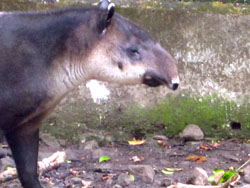 several wood and rope suspension bridges that swayed with every step. The diversity of the greenery all around us, the bright flowers and scents and sounds were exotic and kept a person looking for wildlife, but with the number of people passing along the loop trail, I am sure the animals were keeping their distance – at least from me. The path led us to a view of the Chorro del Macho waterfall. It is the largest waterfall in the area, and supposedly has a great swimming area at its bottom, but we never got an opportunity to make use of it.
several wood and rope suspension bridges that swayed with every step. The diversity of the greenery all around us, the bright flowers and scents and sounds were exotic and kept a person looking for wildlife, but with the number of people passing along the loop trail, I am sure the animals were keeping their distance – at least from me. The path led us to a view of the Chorro del Macho waterfall. It is the largest waterfall in the area, and supposedly has a great swimming area at its bottom, but we never got an opportunity to make use of it.
The path was narrow, allowing only a single file line. At the head of the trail, we were offered walking sticks – being in a rain forest, the trail was wet and maybe a little slick in places. Allen and I declined but the French speaking woman and her husband in front of us did each take one. Within minutes, her husband decided that he didn’t need a stick and gave it to his wife. Every few minutes she would turn around, pointing one of the sticks at me and kind of insisted that I take it. I refused over and over again. Several times she or her husband were just going to leave one of the sticks on the side of the trail, but I would speak out and say “Shame, shame” at them, and they would hold on to the stick. It did not keep her from continuing to offer me one. Allen was tickled by her attempts to give me her stick, as well as her outfit – honestly, when your butt is that big and the flesh tends to move around like hamsters under a blanket, clinging Capri pants might be the wrong outfit. Of course, after looking at some of our beach pictures taken during the trip, I should not be baring my gut in public either.
After completing the trail we were then bussed to the public hot springs / spa. It is a small, park-like area centered around three thermal hot spring pools of mineralized water. There were also two holes in the ground that allowed access to mineralized mud. Mother nature was kind enough to make one mud gentle enough for sensitive skin and the other, more robust mud for normal skin. We were invited to use wooden spoon s (no dipping into the mud holes with your bare hands) to scoop out some mud and apply it to our faces or other body parts as a rejuvenating mud mask. The chamber of commerce says about the mud:
“The mud increases the cells' water content, cleans pores, eradicates impurities and dead cells, and mineralizes the skin. A mud treatment will leave a cool sensation, due to the energy discharged from the body. The procedure will tone and reactivate the skin's enzymatic development. The mask will allow the minerals to absorb into the skin.”
After applying the mud we were then free to change into swim shorts and take advantage of the thermal baths to relax and continue the healing. Allen and I went with the mud masks, but after looking at the pools, we decided against the bath. One would expect the natural minerals to give some coloring to the waters, but this seemed a bit too colored for our sense of sanitation. So, we simply waited around for our mud to dry, watching others apply their own mud masks, and watching young and old alike rejuvenate before our very eyes. Or at least acquire a ruddy glow.
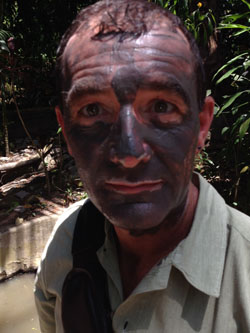 Fully rejuvenated, we were then set free in the market area to browse through the offerings of fresh fruits and vegetables, handicrafts, souvenirs, textiles and anything else someone might want to buy. We wandered through the market and other shops and stores along the main boulevard in and out of town. The only thing we bought though was a couple of diet cokes.
Fully rejuvenated, we were then set free in the market area to browse through the offerings of fresh fruits and vegetables, handicrafts, souvenirs, textiles and anything else someone might want to buy. We wandered through the market and other shops and stores along the main boulevard in and out of town. The only thing we bought though was a couple of diet cokes.
The trip back to the resort became a little scary at one point when a car seemed to be getting too close to the side of the bus, then rushing ahead and jumping from one lane to another in front of us and the other vehicles sharing the 2 lane highway. At times driving down the middle between the two lanes. Luckily, either because he got off the road, was pulled over or decided to look up from his phone, the car seemed to disappear and we continued unmolested.
This had been our last excursion and the rest of our time in Panama was spent in the pool, on the lounge chairs, walking along the beach, in the buffet lines and, for Allen, increasing his supply of shampoos and creams (he found the supply closet), not to mention sitting each night with our Canadian friends and drinking lots of wine (some nights, too much).
The resort sits on the edge of Santa Clara beach. The beach is incredibly unoccupied and a pleasure to walk along, though there were some concerns about jellyfish. We walked for hours, inhaling the sea air, listening to the beating of the surf, watching sand crabs scamper away from us. In one direction the beach was littered with seashells that matched the color of Maxim’s china, Allen began collecting the best examples of this color match for a display he wanted to do at home.
Any houses or buildings were mostly built far enough off the beach that you really did not notice them. There were a number of fishing boats on the beach, close to the canopied huts of the fishermen, their piles of netting sitting in them. I have no idea how they keep them from getting all tangled up. Mostly though, the miles and miles of beach, were deserted. Maybe a dozen other people were out walking when we were – of course; it was also the middle of the day and kind of hot. What a great feeling of quiet and being at one with the surroundings, the sand squishing through our toes, the sun, the waves, the “otherness” of so much beautiful beach and so few people.
These were days really spent in a sort of paradise. Barefoot and in shorts – in February! The warmth and bright skies, the tropical plants and mountains, the sand and seas. It was a magical week, sorely needed and ended all too soon. It was very difficult to leave. Going back to our ruined home, to our jobs, to gloomy, dark, cold Chicago – it was painful even thinking about.
Our flight back to Chicago was comfortable and pretty uneventful. The Panama airport seemed more mall than airport. We touched down in Chicago around 11PM and in my haste to get out of the plane, I left behind the mask we bought in Panama – not noticing its absence until we were in the parking lot and loading our bags in the truck. Damnit! It was in the 20’s, snow had recently fallen, and we could once again see our breath. The drive back was swift and when we got into the house we saw that the floors had been repaired and re-done, that was great, but no genies had been by to fix all the other stuff… in other words we were banished from paradise and crash-landed back into reality.
We’d go back tomorrow if we could. Panama is worth seeing.
MORE BEACH AND ZOO PICTURES

